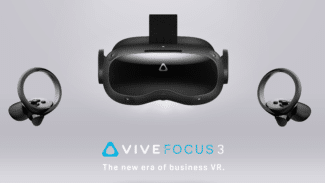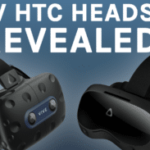HTC just officially revealed Vive Focus 3, an advanced standalone VR headset for businesses. Here’s the full Vive Focus 3 specs.
It’s got a Snapdragon XR2 processor, a 5K LCD set to 90 Hz, HTC’s new wider lenses, a magnesium alloy frame, built in speakers, and a swappable battery.

Four wide angle cameras are used for head and controller tracking. HTC says controller-free hand tracking support will arrive after launch.
Vive Focus 3 goes on sale June 24 for $1300. That includes a 24 month business warranty and Vive software services.
Snapdragon XR2
HTC’s previous standalone headsets used Qualcomm’s Snapdragon 835 – Qualcomm’s 2017 flagship.
Vive Focus 3 makes the 3-generation jump to Snapdragon XR2, also seen in Facebook’s Oculus Quest 2. It’s a variant of the 865 designed specifically for headsets.

Focus 3 has a copper heat pipe and cooling fan. Vents are visible on the front of the headset. The XR2 in Quest 2 is underclocked, so we’ll be curious to see if HTC’s cooling solution allows for higher clock rates.
2.5K Per-Eye 90 Hz LCD
Vive Focus 3 has a 4896×2448 LCD panel providing 2448×2448 per eye. That’s the highest resolution standalone headset we know of.
| Headset | Total Resolution | Per-Lens Resolution |
| Vive Focus 3 | 4896×2448 | 2448×2448 |
| Oculus Quest 2 | 3664×1920 | 1832×1920 |
| HP Reverb G2 | 4320×2160 | 2160×2160 |
| Valve Index | 2880×1600 | 1440×1600 |
The same display is used in the new Vive Pro 2, though here it’s listed as 90 Hz rather than 120 Hz. Oculus Quest 2 saw a refresh rate increase in a software update, so it’s possible HTC could do the same.
120° Field Of View Lenses
Vive Focus 3 and Vive Pro 2 introduce HTC’s “new bespoke dual stacked-lens design”.
HTC says the new lenses provide a clean 120 degree field of view, without introducing new distortion or blur at the edges. For comparison, it marketed the Vive Focus Plus field of view as 110 degrees.

Like with all HTC headsets so far, Vive Focus 3 has lens separation adjustment.
Swappable Rear Battery
The headset’s battery is located in the rear section rather than in the front. That should mean a less heavy feeling headset with more balanced weight distribution.

The battery is removable, enabling businesses with a spare battery to use the headset all day with only seconds of downtime.
Visible LEDs on the back let you see how much battery is left without needing to put on the headset. HTC says it supports fast charging, going from 0% to 50% in 30 minutes.
Quest-Like Controllers
Focus 3 comes with two VR controllers. They look almost identical to the original Oculus Quest’s controllers, and also contain infrared (IR) LEDs under the tracking rings.
These IR LEDs are tracked by the four cameras on the headset.

Unlike most other VR controllers, the battery is not removable. Each controller is charged via the USB-C port at the bottom. HTC claims 15 hours of battery life.
Specs Comparison
Here’s how Vive Focus 3 stacks up to the other available standalone VR headsets for businesses:
| Vive Focus 3 | Oculus Quest 2 | Pico Neo 3 Pro | |
| Display per lens | 2448×2448 | 1832×1920 | 1832×1920 |
| Refresh Rate | 90Hz | 72-120Hz | 90Hz |
| Field of View | Wider | Standard | Standard |
| Lens Separation Control | Granular 57mm-72mm | 3-Stage (58mm/63mm/68mm) | 3-Stage (58mm/63mm/68mm) |
| Battery | Removable (Rear) | Built-In (Front) | Built-In (Front) |
| Price for business | $1300 | $799 | $699 |
What do you make of the Vive Focus 3 specs? Let us know in the comments below!





